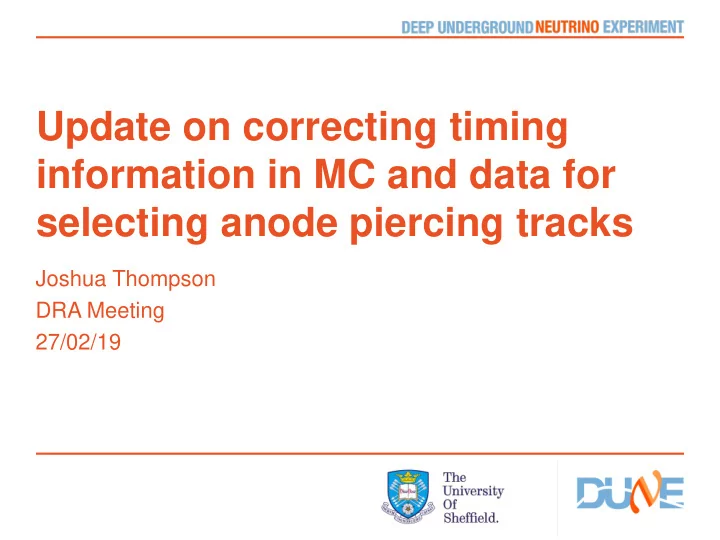

Update on correcting timing information in MC and data for selecting anode piercing tracks Joshua Thompson DRA Meeting 27/02/19 You Inst Logo
Anode piercing tracks diagram • Stephen requested a diagram showing the process of selecting anode piercing tracks: 2 27/02/19 Joshua Thompson | Corrected timing information for selecting APT You Inst Logo
Resolving MC timing issue • The wide spread of time differences in MCC11 (l) strongly suggested that the flashes were not being correctly matched to tracks and the matches were through random coincidence. • To establish whether this was due to an offset between the timing systems, I have plotted the time difference between anode piercing track candidates and all flashes in each event (r). A clear peak is visible at 250 µs, which corresponds to an offset in MCC11 which I had not been accounting for previously. 3 27/02/19 Joshua Thompson | Corrected timing information for selecting APT You Inst Logo
Resolving data timing issue • The spread in the data (l) looked similarly wide and incorrect. Using the same technique, I looked at the time differences in data (r). • Using the flash time as stored, no peak can be seen but there is an unusual pattern in the number of flashes matched against the time difference. 4 27/02/19 Joshua Thompson | Corrected timing information for selecting APT You Inst Logo
Examining flash times closely • I have previously shown the shortened flash time window, from roughly -800 to +900 µs (c). • When zooming in to the end points, these values are more precisely -750 (l) and 915 µs (r). These are exactly 1/3 of the photon detector readout window, which runs from -2.25 to 2.75 ms. 5 27/02/19 Joshua Thompson | Corrected timing information for selecting APT You Inst Logo
Correcting flash times • I have taken these stored values and multiplied by 3 to give a corrected flash time. • Comparing this corrected flash time to reconstructed t 0 shows a clear peak, close to zero, which strongly suggests that this corresponds to correctly matched particles. 6 27/02/19 Joshua Thompson | Corrected timing information for selecting APT You Inst Logo
MC Matched flash time difference • Correcting for these issues, I have produced plots of the matched flash time to reco time difference for MCC11 and data. • In MCC11 (l, zoomed in r), the matching now produces a narrow peak which looks to correspond to correctly matched anode piercing tracks and flashes. 7 27/02/19 Joshua Thompson | Corrected timing information for selecting APT You Inst Logo
Time difference in data • The peak is not as narrow in the data, but it does appear to be centred fairly well, with a small offset that is not otherwise accounted for yet. • However, no cuts have been applied yet beyond a nominal minimum 20 PE and 5 cm track length, so applying cuts of this nature will likely narrow the peak region. 8 27/02/19 Joshua Thompson | Corrected timing information for selecting APT You Inst Logo
Initial purity in MC • For the MC, I have taken tracks matched to MC particles which start/end at the anode plane and treated these as true anode piercing tracks. • In the peak region, there is little difference between the two distributions, with a - 2 to +1 µs cut giving 95.4% purity of ‘true’ anode piercing particles selected in this way, for MCC11, with no other cuts applied, and 64.0% efficiency. 9 27/02/19 Joshua Thompson | Corrected timing information for selecting APT You Inst Logo
Next Steps • I will implement the T0Offset parameter for the MC, in case this changes in future productions. • Further studies on the purity using the MC, including studying the method of determining true anode piercing particles and determining which cuts to apply to select tracks. • Further ahead, using cryostat side hits to corroborate data selection and determine purity. • Then we can start using anode piercing tracks to actually study space charge! 10 27/02/19 Joshua Thompson | Corrected timing information for selecting APT You Inst Logo
Recommend
More recommend